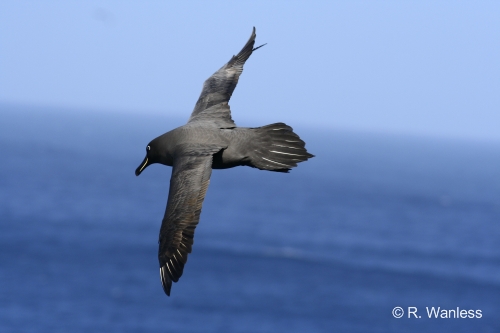Extra-pair copulations (and in some cases ensuing extra-pair paternity or EPP) have been reported for several species of albatrosses, including Wanderers Diomedea exulans (click here), Waved Phoebastria irrorata and Laysan P. immutabilis and several species of mollymawk albatrosses Thalassarche spp. (see references below).
A skewed sex ratio, with a predominance of males, has been suggested as a cause in Wanderers. Skewed sex ratios may be due to differential mortality on longline hooks, with the more northerly foraging females coming more into contact with fishing vessels than do the more southerly-foraging males.
While setting up a new demographic study of Sooty Albatrosses Phoebetria fusca on Gough Island last month (click here) I observed serial extra-pair copulation (EPC) attempts following banding a female (sex determined by bill measurements) that was sitting next to a nest occupied by its presumed male partner prior to egg-laying.
On release at its nest site the female moved within a metre of a nearby nest occupied by a pre-laying male. This male left its nest and initiated copulation with the apparently quiescent female. Because this had been caused by our presence I moved the male aside and guided the female back towards its own nest. On its way it passed close by a second pre-laying male who also then left its nest and initiated copulation by mounting. Once again the female did not appear to object. At this stage the female's partner called and left its nest and moved towards the copulating birds in an aggressive manner. I again interrupted the attempted EPC event and guided the female back to its original nest, which had been re-occupied by its partner.
As we left the small colony of six pairs we observed the female picking up pieces of dried tussock grass and placing them against the nest bowl. All looked back to normal.
It remains to be seen whether EPC in Sooty Albatrosses occurs naturally in the absence of human disturbance - but based on the above observations it seems likely that it does.

A Sooty Albatross flies past the cliffs of Gough Island
Photograph by Ross Wanless
Selected references:
Abbott, C.L., Double, M.C. & Cockburn, A. 2006. Copulation behaviour and paternity in Shy Albatrosses (Thalassarche cauta). Journal of Zoology 270: 628-635.
Burg, T.M. & Croxall, J.P. 2006. Extrapair paternities in Black-browed Thalassarche melanophris, Grey-headed T. chrysostoma and Wandering Albatross Diomedea exulans at South Georgia. Journal of Avian Biology 37: 331-338.
Huyvaert, K.P. & Parker, P.G. 2010. Extra-pair paternity in Waved Albatrosses: genetic relationships among females, social mates and genetic sires. Behaviour 147: 1591-1613.
Jones, M.G.W., Techow, N.M.S.M. & Ryan, P.G. 2012. Dalliances and doubtful dads: what determines extra-pair paternity in socially monogamous Wandering Albatrosses? Behavioral Ecology and Sociobiology DOI: 10.1007/s00265-012-1374-8.
Jouventin, P., Charmantier, A., Dubois, M.-P., Jarne, P. & Bried, J. 2007. Extra-pair paternity in the strongly monogamous Wandering Albatross Diomedea exulans has no apparent benefits for females. Ibis 149: 67-78.
Research on albatrosses on Gough Island is funded by the UK's Overseas Territories Environment Programme via the Royal Society for the Protection of Birds and by the Percy FitzPatrick Institute, University of Cape Town, and is supported logistically by the South African Department of Environmental Affairs. Research activities on Gough are conducted with the support and approval of the Tristan Conservation Department.
John Cooper, ACAP Information Officer, 10 October 2012

 English
English  Français
Français  Español
Español